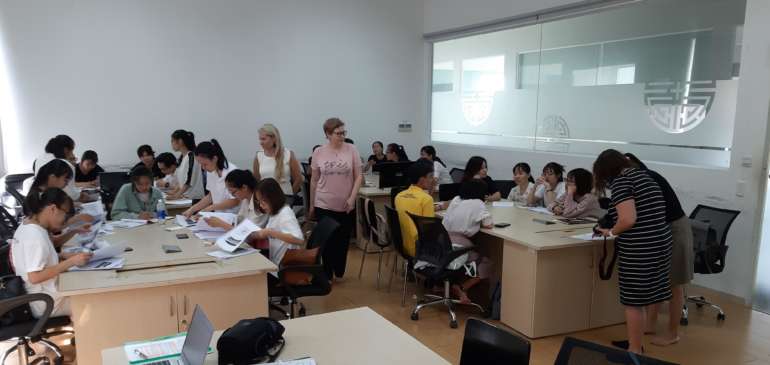Three Exciting Features of the “Communication and Interaction Competencies” Intensive Course in Vietnam

There were some new and exciting features of the courses, although there were some cultural and educational differences among participants that can be perceived as a richness.
It was also very clear that you should know the culture of students in international teaching activities. As one of our active DVINE teaching staff members in the “Communication and Interaction Competencies” course in Vietnam stated:
Cultural content needs to be taken into consideration in every phase of the course. They use a kind of roleplay, but simulation as a pedagogical method is a new thing for them, and it worked well in this course. The multi-professional approach was also new, as were communication and nursing tools like ABCDE, NEWS, and ISBAR.
At the end of the course, all the participants were asked for their impressions of the course. Three of the most exciting features of the “Communication and Interaction Competencies” course in Vietnam, identified by all the student participants, are shared in this blog.
1. Learning healthcare tools such as ABCDE, ISBAR, and NEWS interested students
Some social work and nursing students expressed their feelings about learning and understanding the importance of healthcare tools such as ABCDE, ISBAR, and NEWS in the “Communication and Interaction Competencies” intensive course in Vietnam:
Some student statements about what they learned:
“The ISBAR and ABCDE tools offer a clinical assessment of the patient via the ABCDE tool”; “ABCDE, ISBAR, and NEWS show you how to handle the situation”; and “The ISBAR tool helps the learner assess the patient’s status clearly, safely, and reliably”; “ABCDE enables the patient’s clinical assessment”.
“Provides tools and basic knowledge”; “Gives you more understanding of ISBAR and ABCDE”; “Helps you obtain new knowledge”; and “Supplies new information and knowledge of whioch we were previously unaware”.
2. Exciting learning activities that improve students’ communication skills
In the “Communication and Interaction Competencies” intensive course in Vietnam, it was ensured that students from different professions worked collaboratively by developing some communication skills.
Some sign language, picture communication, and symbol communication techniques were also used in the course. Some social work and nursing students expressed their feelings about developing their communication skills and understanding the importance of using other supportive ways to facilitate communication in the intensive course as follows:
Some student statements about what they learned:
“Knowing how to communicate non-verbal language, sign language”; “The importance of communication; Picture/symbol communication”; “How to connect with each other in a group. How to communicate with the patient”; “Communication skills with patients; Teamwork”; “How to communicate with the hearing impaired”; “The simulation method was extremely useful”; “I learned about teamwork when we discussed together. Learning to solve problems when I meet a patient. Learning body language and using pictures to communicate with the patient”; “Communication skills for working with patients; Emerging problem-solving skills; Sign language and pictures; Teamwork skills”; and “Observation, carefully identifying a problem, assessing the patient’s needs; Empathy”; “Communicating with the patient to relieve their pain”.
“Good interaction between teachers and learners”; “Develops a student network. Teamwork; Problem solving; Sign language”; “Teamwork between social and medical students; The importance of sign language”; “Communication skills for students; Problem solving”; and “Increasing communication skill for students; Promoting group discussion; Solving some cases”.
3. Very exciting creative simulation techniques adapted to culture
In the “Communication and Interaction Competencies” intensive course in Vietnam, students were very excited about some of the realised simulation applications. These simulation activities were created, organised, and implemented with teachers and students. Some social work and nursing students expressed their feelings about the applied simulation methods in the intensive course as follows:
Some student statements about what they learned:
“Problem based learning (simulation situation)”; “Learning experience through simulation”; “How to connect with each other in the group”; “Teamwork skill”; and “The simulation method is extremely useful”.
“Student-centred teaching; Learning by simulation”; “Real situations; Students could join in real scenarios, which helped them improve their skills”; “Helping students develop proactively and creatively; Good teamwork and a student network”; “Applying the scenario in reality; Knowing how to solve a patient’s problem”; “With simulation, students can apply tools in the practice”; “A good teaching method; Discussions with teachers”; “Teaching method. Activating students. Cases very interesting”; and “Helps students: Thinking, creating, developing”.
Text: Dr Şeref TAN
Main image from the “Communication and Interaction Competencies” intensive course in Vietnam in November 2019. Picture by Şeref TAN
